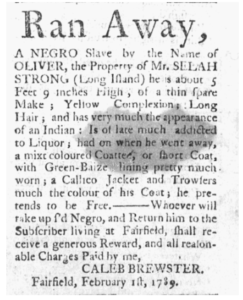By Alec Lurie
Fans of AMC’s show TURN know him as a spy, a Patriot soldier, and a rugged sailor of the Long Island Sound. But Caleb Brewster—Fairfield, Connecticut’s resident member of the Culper Spy Ring during the Revolutionary War—was also an active participant in the African Slave Trade.
Runaway Advertisement in the Fairfield Gazette
In winter 1789, Caleb Brewster was busy writing. With the American Revolution over, he stopped sneaking hidden messages to the Continental troops and crafting covert messages in invisible ink. Instead, he was writing an advertisement to be printed in the Fairfield Gazette for the whole community to read. Caleb Brewster was hunting down a runaway enslaved person.
His name was Oliver, and he slipped away into the cold with only the hope of escape and the lie that he was legally free. Oliver was a “negro” man, who may have had some Native heritage. Brewster’s advertisement claimed that Oliver “is of late much addicted to Liquor” and that he “pretends to be Free.” Runaway enslaved people were perfectly common during this period and the frustration of enslavers littered early American newspapers in advertisements like this one, giving detailed descriptions of their target’s appearance and the circumstances of each escape.
But this was not a typical runaway ad. Brewster did not own Oliver, someone else did—Selah Strong. Another significant player in Revolutionary espionage, Selah Strong was an equally ardent patriot, a Setauket, Long Island native, and the husband of purported spy, Anna Smith Strong.
According to legend, Anna Strong was the Culper Spy Ring’s maritime messenger, using a clothesline to signal safe landing points to Caleb Brewster. For the most part, however, oral tradition—rather than hard evidence—has supported Anna’s role in the American intelligence operation.
It is not surprising that Caleb Brewster and Selah Strong knew each other. Both men were originally from Setauket. They shared neighbors, as well as political views. This advertisement, however, strengthens the evidence of a personal relationship between Brewster and the Strongs. Furthermore, Brewster instructed anyone who found Oliver to bring him to Brewster’s own home in the Black Rock district of Fairfield (an area that is now in Bridgeport). It is clear through this advertisement that Brewster was friends with Selah Strong and probably knew his wife, Anna. In fact, Brewster would have had to pay to publish an advertisement in the paper, so it is likely that they were good friends.
Caleb Brewster and the African Slave Trade

Caleb Brewster biographical entry – History and Genealogy of the Families of Old Fairfield, V.2, Pt.2 by Donald Lines Jacobus
If Selah and Anna Strong enslaved Oliver, then why did Caleb Brewster publish the runaway advertisement? There is no way to be sure, but possible explanations may help us better understand the relationship between Caleb Brewster and the Strongs, as well as their involvement in slavery.
The Strong family could have paid a visit to their wartime associate in Fairfield. Their enslaved people likely would have traveled with them on such an excursion. Did Oliver use this outing as an opportunity to flee into the New England mainland, where few, if any, would recognize him as a fugitive?
Another possibility is that Brewster “rented” Oliver’s labor from the Strongs. It was not uncommon for people to pay enslavers a fee in order to use their enslaved labor for a fixed term. Is this why Brewster had some stake in Strong’s “property” and subsequently published the advertisement?
The third explanation is related to Caleb Brewster’s role as a courier during the Revolutionary War. He traveled the waters of the Long Island Sound in darkness, relaying messages as part of the Culper Spy Ring. Less than a decade since the end of the war, it is possible that Brewster facilitated the purchase of enslaved people by or for Selah Strong across the Long Island Sound. Perhaps, in the winter of 1789, Oliver escaped the interstate slave trade.
Whatever the case may have been, Caleb Brewster and the Strongs, who fought and nearly died for the idea of “freedom,” forcefully denied that freedom to Oliver. While we do not know what became of Oliver, we do know that Brewster’s involvement in American slavery only grew more tangled. Between 1791 and 1794, at least three enslaved infants were born in the Fairfield home of Caleb Brewster. Their names were Dinah, York, and Charles. It seems that in the eyes of these patriots, the cause of liberty did not apply to all.
Alec Lurie is a Columbia University graduate, educator, and the historical research lead for the Fairfield Slavery Project through Fairfield University.









